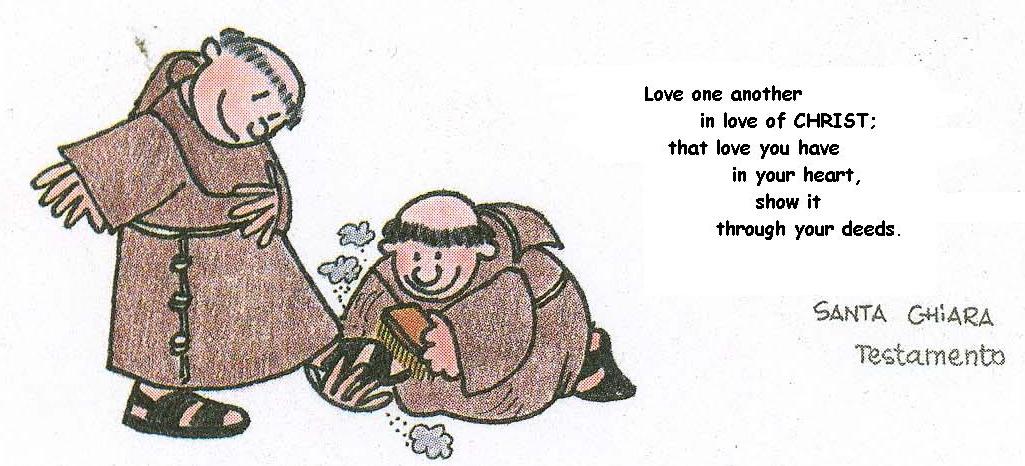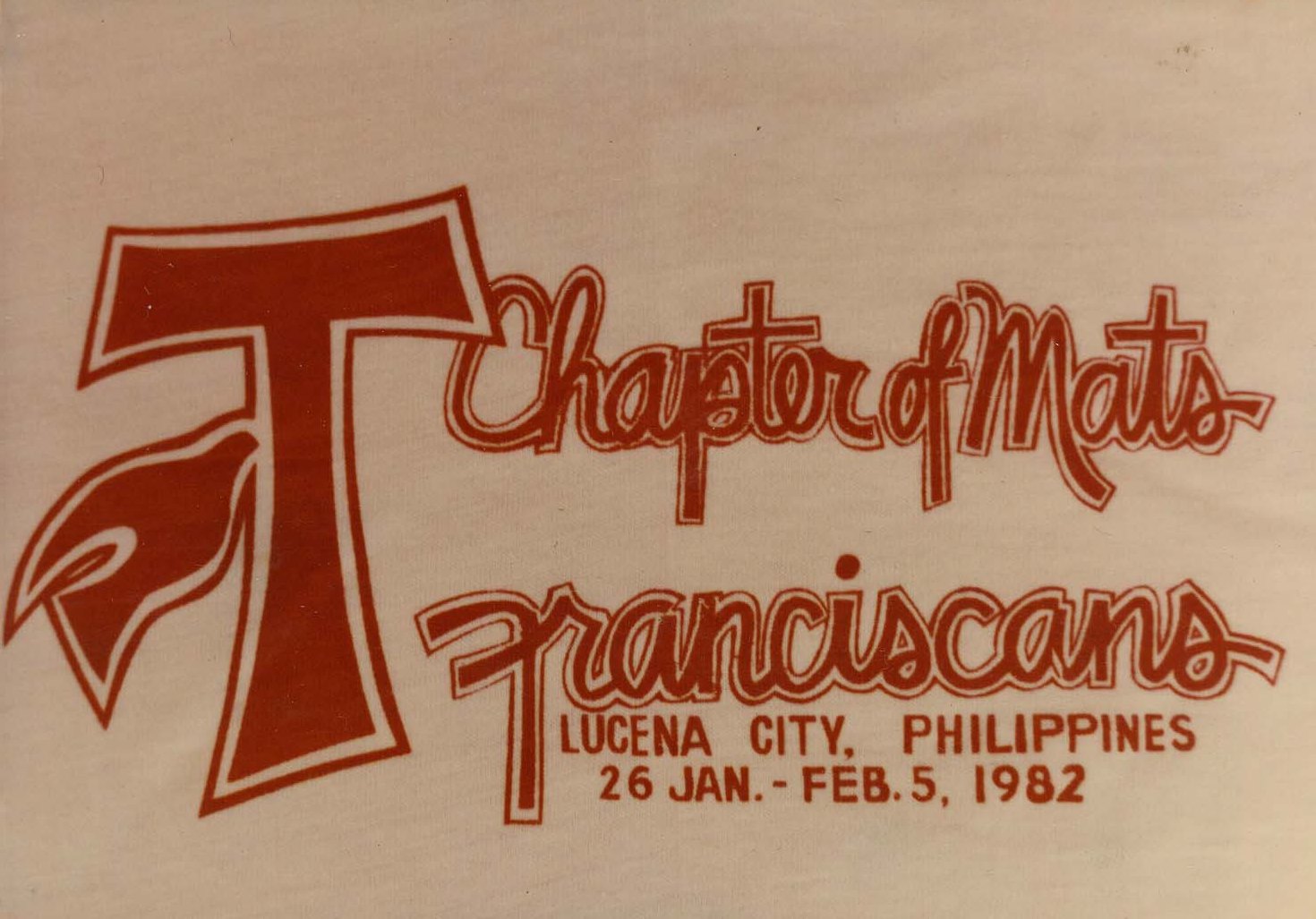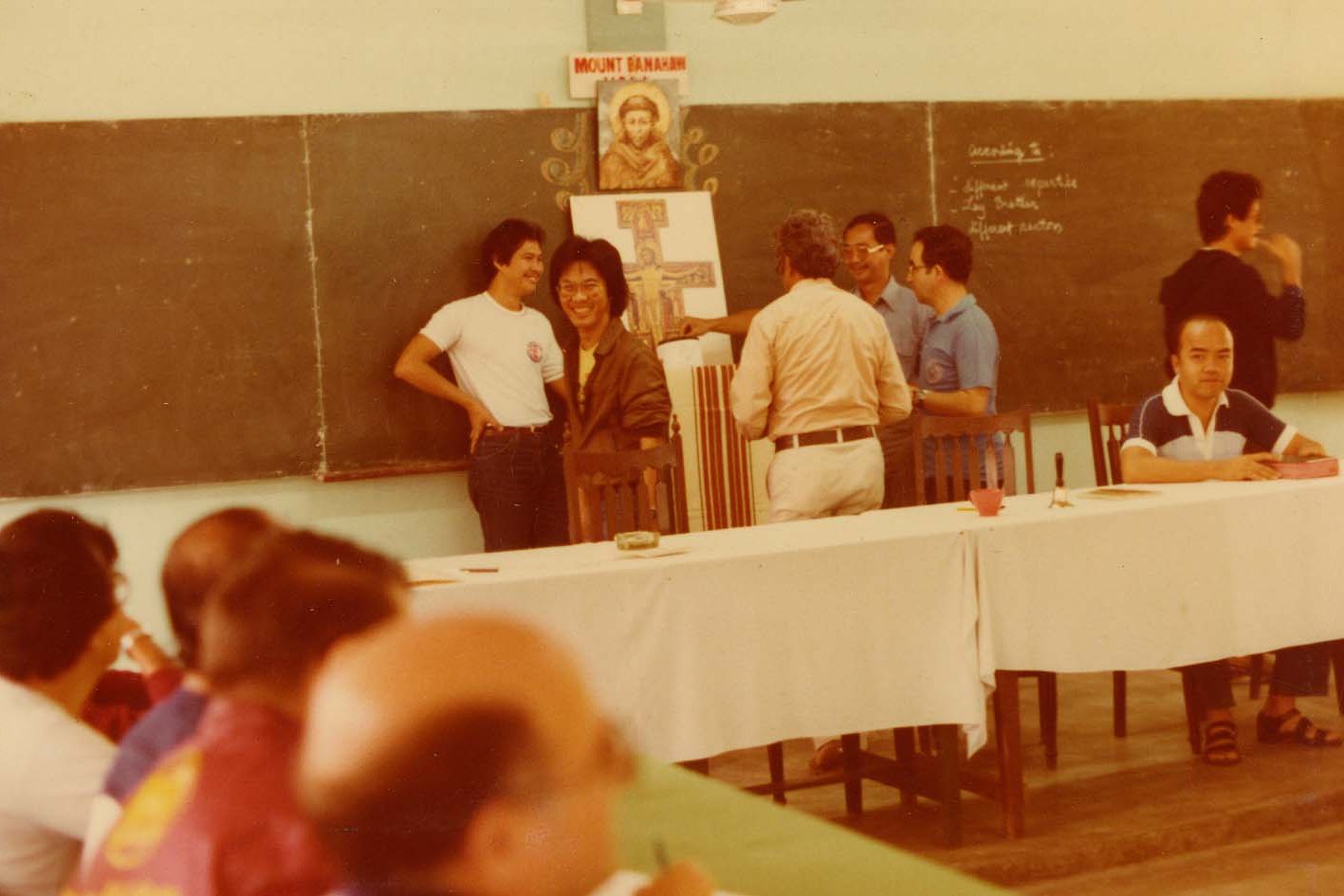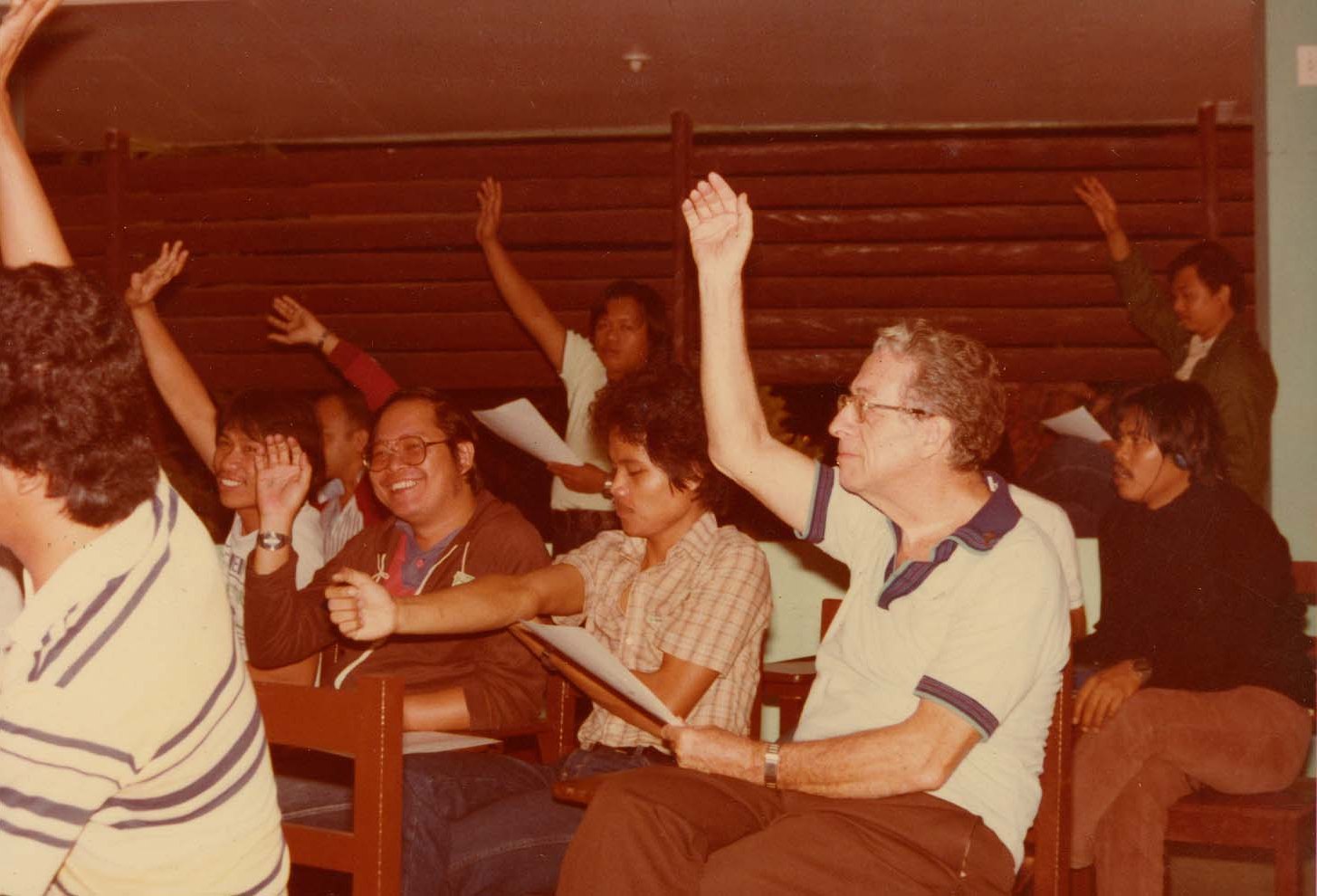|
OFM ARCHIVES PHILIPPINES |
|
|
Recent Articles
“A watch that has a gold chain but which does not tell the time is worthles."
Franciscan Bookreviews: Franciscan History by André Cirino OFM THE FRANCISCANS. William Short, OFM. Michael Glazier, Inc. [Now distributed by
Liturgical Press]. Wilmington, De. 1989. 152pp. This work by Bill Short provides us with a compact survey of the
history of the entire Franciscan Order. It is a summary of the Order's development down through the centuries that provides
a good introduction to those reading this history for the first time. It whets the appetite to pursue this history further,
perhaps by reading a work like Duncan Nimmo's REFORM AND DIVISION IN THE MEDIEVAL FRANCISCAN ORDER, (Rome: Capuchin Historical
Institute, 1987). Bill's chapter on "The Franciscan Spirit" is a gem in its description of "the spiritual environment in which
it (the Franciscan family) lives and grows, and the climate it creates around itself." Bill concludes: "In these pages I have
assembled a series of snapshots, pieces of a family portrait, that of the Franciscans." He has indeed succeeded in doing just
that. Recommended for course work for Secular Franciscan fraternities as well as for friary libraries. This book would be a sine qua non for the summary it gives of the
biblical and Franciscan understanding of penance, the origins of the penitents from the third century up to the time of Francis.
Besides his development on how Francis himself became a penitent, Pazzelli has an excellent treatment on the First Letter
to All the Faithful (Recensio Prior--the Volterra text) as well as the later or second version of the Letter to All the Faithful.
"The Letter to all the Faithful could have undergone a development similar to that of the RNB (also known as the Earlier Rule)
of 1221. As we know, the RNB is the result of that Protoregula of 1209 (1210). . . .In the same way, Francis could have added
to and modified this Volterra text until he had the long or final edition, the Letter to All the Faithful." Anyone who works
with TOR communities or SFO fraternities will appreciate his work on these two texts. Pazzelli's writing on both is solid
research presented clearly and succinctly. Definitely recommended for SFO spiritual assistants, friary, convent and SFO libraries. In the words of the authors, this is a "rapid overview of the history
of the Order. For the most part, we have stressed people and institutions. . . ." As a survey of Franciscan history, the authors
go through every century down to the twentieth, presenting primarily a survey history of the first order with glimpses into
the other branches. It is recommended for SFO and friary and convent libraries. FRANCIS OF ASSISI AND THE FRANCISCAN MOVEMENT. David Flood, OFM. The Franciscan Institute of Asia. Quezon City, Philippines.
1989. 173pp. Anyone who has ever read David Flood's writings or heard him speak
will know that David approaches early Franciscan history almost exclusively from the writings of Francis. David, a former
student and later colleague of Kajetan Esser, OFM, says: "The study of Franciscan
history begins with an analysis of the basic document (the Early Rule). For the text manifests the intelligence in which Francis
and his brothers fashioned the action called the Franciscan movement. That action differed sharply and consciously from the
action prescribed by Assisi for its citizens. . . .The Early Rule throws open the door on the early Franciscan years. In the
phrases of its development, in the variety of its themes, it offers itself to us as an oracle ready to answer all our questions.
We have but to put the questions well. It is better than an oracle. It abhors
ambiguity." In four chapters David formulates fascinating questions and the Early Rule has equally fascinating responses.
The book has a unique approach to our early history. It is highly recommended for serious study or course work, for reflection,
and for all SFO and friary or convent libraries. It can be ordered from The Franciscan Institute of Asia, P.O. Box AC 570
Cubao, Quezon City, Philippines. "One day, the foolhardy desire of a man, or perhaps
the desire of a group of men, encounters a marvelously expressive gospel text. Joy quickly emanates from the encounter: 'Here
indeed is what we have been seeking!' In their desire, their encounter, their joy--in all three elements gushing forth from
the same pure mountain spring--with the striking clarity of a starlit sky, they discover the Franciscan Intuition: to follow
in the footsteps of Jesus Christ."[p.133] Desbonnets, [RIP 8 July 1988] has a finely researched work that
traces this intuition from its inception to its institutionalization. His analysis of the texts is critical and clear. His
deduced insights are both new and refreshing. Some chapters along the way are:
The Early Plan; Francis' Resignation; Brotherhood; Clericalization. I found his insights on brotherhood/fraternity particularly
enlightening. Desbonnets comments on Solet annuere, the papal bull approving the
Rule of 1223, asking: "What could possibly have been the intention with an approval granted by means of the banal formula,
Solet annuere?" Desbonnets says "this administrative formula was routine and
involved no solemnity." There were 135 Solet annuere bulls issued by Innocent III and Honorius III. His insights on this and
other questions are fascinating and provocative. It is recommended for any Franciscan's reading and
a good addition to any library, especially houses of formation. Peter John Olivi, contrary to the Italian-sounding name he bears,
was born in 1247/48 in southern France and died in 1298 and was buried at Narbonne. "He had entered the Franciscan order in
1259 or 1260 at the age of 12. He was a student in Paris by the later 1260s, but probably never taught there"[p.38]. He was the writer around when much of the Usus Pauper controversy surfaced. Burr writes: Neither
side of the Usus Pauper controversy can be can be identified precisely
with the views of Saint Francis; yet in one sense Olivi catches the spirit of early Franciscanism as his opponents do not. His
approach is more faithful to the spirit of adventure found in Franciscan
legend. When a young Franciscan vows the rule, he embarks on a spiritual quest.
The vow points him toward a goal and encourages him to travel in that direction.
It does not offer a cook- book religion in which all the necessary ingredients are measured out to the nearest quarter-teaspoon. The boundary between...bending the vow and breaking it, remains unmapped. Nor
can it ever be charted. It is beyond the simplistic human measurement.
The Franciscan life is thus challenging and exciting, but these qualities are
purchased at the cost of some uncertainty and thus some anxiety. In stark contrast the life offered by Olivi's
opponents seems less susceptible to uncertainty and anxiety, but it is as adventurous as lunch at a modern fast-food restaurant.
The cost is reduced to a set price, and it is a price anyone feels he can afford; yet the value received is scaled down accordingly. The result is predictable but not very exciting. [Olivi] was by no means the sort of person who clings to old formulations through
a need for familiar, clear answers. On the contrary, he was probably more comfortable with uncertainty than were most theologians of his time, more willing to live with open questions, and more adventurous. He displayed a noteworthy independence in deciding
what should be accepted or rejected.[pp145-46] Duncan Nimmo writes in his book Reform And Division In The Medieval Franciscan Order, that with the rise of the Spirituals, Olivi stands out
as "a speculative thinker of considerable stature," a scholar and writer par excellence.
Olivi's impact on the Italian spirituals dates at least from 1287, when
Ubertino [da Casale] came to know him at Florence. Perhaps it dates from 1279. Of course, as we see from Ubertino and Angelo [Clarinus], the Italian spirituals made
odd use of Olivi; yet, however much they may have distorted him. . . , any Franciscan leader who took the trouble to read
his work could see that he resembled the rebels in his insistence that defying authority on the matter of usus pauper was
not simply a right but a sacred duty when the purity of the rule was at stake. [p.172] Nimmo holds that Ubertino and Angelo took Olivi's scholarly writing
and popularized it in their own works for their followers. Burr gives another view of Olivi when he compares him to Bonaventure.
He writes: His stance was in some ways similar to that adopted by
Bonaventure in his declining years. Both saw slippage in their own day but at least acted as if they thought it could be arrested
or even reversed. The amount of decay seen by each was limited by the fact that
both saw the development from Francis' time to their own not as a fall from original
innocence but as a progression. The order had changed remarkably during those decades, accumulating a large membership, new responsibilities, and a great deal of power. Instead of bewailing these alterations,
Bonaventure and Olivi both accepted them as positive accomplishments. Thus they sought not a return to the original standards
of Rivo Torto and the Porziuncola, but a maintenance of a modest yet salubrious existence within a well-administered community,
allowing the brothers to fulfill their responsibilities in the world while edifying it with their behavior [pp.179-80]. Burr has produced a scholarly work on Olivi and the Usus Pauper
controversy. It shows us more of this friar than historical works sometimes protray in summary fashion. Burr has written articles on other aspects of Olivi's writings. This text makes for serious reading. It
should be on the shelves of our study/formation libraries. As I was preparing a few classes on the Capuchin Reform for our
novices, I received a copy of this book. Finished in 1963 as a doctoral dissertation at the Gregorianum University of Rome,
the present edition includes the entire original dissertation along with an updated though select bibliography. The author basically establishes who the Spirituals were in our
Order's history with a good summary in chapter III on the doctrine of the Spirituals. MacVicar writes: The master idea of the early Capuchin legislation is the
perfect imitation of St.Francis and complete fidelity to his every intention and wish. The opening chapter of the Constitutions
of 1536 lays down the fundamental principles by which the Reform hopes to accomplish its perfect renewal of primitive Franciscan
life. 1. The friars shall observe the Holy Gospel in the manner prescribed by
St.Francis. When they speak of the Gospel life, they understand its obligations for the Order according to the papal declarations. 2. They shall observe the Rule to the letter, and without gloss. 3. They shall observe the Testament of St.Francis. 4. Over
and above the Rule and Testament, they shall model themselves on all his words
and works. 5. The general chapter renounces in the name of the Order all privileges
and exemptions which tend to relax the Rule [pp.57-58]. Having already shown earlier in the text that the "doctrine
and mentality (of the Spirituals) were full of exaggerations"[p.60], nevertheless, "purified of the exaggerations their principles
were basically sound and seemingly the only workable plan for renewing the primitive observance" [ibid.]. "We merely wish
to show that the early Capuchins received from the Spirituals, though not from them exclusively, the fundamental principles
of their reform"[p.61]. This last statement seems to be in opposition to the author's ultimate conclusion. In the principles enunciated above, it would seem that there could
be a discrepancy between numbers one and two. The Spirituals, according to Duncan Nimmo [Cf. REFORM AND DIVISION IN THE MEDIEVAL
FRANCISCAN ORDER] basically strove for literal observance of the Rule, Testament, and the entire Gospel. For them, papal declarations
would be considered a "gloss," the first in a long line of which would be the papal bull Quo Elongati of Gregory IX. It stated
that the Testament was not binding for the friars, only the Rule was. Moreover, they were bound by obligation only to observe
those passages of the Gospel contained in the Rule, not to the entire Gospel. The author is concerned mainly with comparing the early Capuchins
with the Spirituals to discover if they were "mentally and historically the inheritors of the Spiritual tradition." He writes in his final chapter: "As a final conclusion to our entire
study, we can say that in the origin and development of the Capuchin Reform, Spiritual influence properly so-called was limited
to an overemphasis in the initial years on the eremitical life, a cult of prophecies (Joachimistic), and a certain opposition
to studies...Outside the infiltration of Spiritual doctrine just mentioned, we must deny Spiritual influence as a whole" [p
103]. This work would be valuable in the libraries of our formation houses. This volume published during this centenary year of St. Anthony’s
birth is most welcome. Its format is handsomely presented with each of its sections
accompanied by reproductions of artistic works of St. Anthony. And the biographical
research of Lothar Hardick, OFM is refreshing. Hardick, in a brief biographical
sketch, treats of Anthony’s family background and youth, his becoming a Franciscan, his work in northern Italy, southern
France, his leadership of the Romagna Province, his last years in Padua, the return of the saint to God, St. Anthony today,
and a brief chronology. The value of this solid but short biography is in its excellent
research. And it is brief enough for readers to acquaint themselves with this
very popular saint. The biography gives a good sense of who Anthony was, and
as such it gives the reader a good handle on the facts as opposed to the many legends and devotions that have sprung up around
Anthony. It would make an attractive addition to any Franciscan library. More importantly, this work would be most helpful to those whose ministry involves
devotion to St. Anthony, whether it is used for basic background information for preaching or presentations, or whether it
is made available to devotees of St. Anthony. Raffaele Pazzelli, in this detailed study, traces the origins of
the Franciscan Sisters, i.e., congregations of Sisters of the Third Order Regular. It is an historical study in 13 chapters
of the struggle of the women's congregations (the male TOR friars are included at times) who banded together in communities
while doing some work outside their community such as care for the sick. Pazzelli uses papal bulls as the main focus of his study to unravel
this complicated history. He takes each century from the thirteenth to the present emphasizing the struggle to avoid enclosure
that was the thrust of the Rule of Clare for the second order. Until 1521, these sisters (and brothers) followed the Rule
of Nicholas IV of 1289, a Rule written primarily for Secular Franciscans, "suitable for married people, but not for virgins
and celibates"[p.95]. So Leo X wrote a "suitable" Rule for the third order regular
in 1521. The Council of Trent (1545-63) decreed strict cloister for all women's congregations "causing Franciscan sisters
to pass from the status of...sister to...cloistered nuns" [p.101]. As Pazzelli
moves to the 17th and 18th centuries he treats of new congregations that arise "because of life's circumstances" [p.121],
the Franciscan sisters being distinguished by the special attention given to
the care of the sick in hospitals, in rest homes, in homes for the elderly, in
charitable activity among the very poor, sheltering homes for the orphans and educational programs for children and youth,
particularly for young girls [p.129]. Pazzelli moves throuigh the centuries down to the present by highlighting
the origins of a sample of Franciscan sisters' congregations, showing how the Holy See gradually shifted gears from prohibiting
to encouraging the formation of new congregations. The author touches on the Rule of Pius XI, leading to his treatment
of the new Rule approved for all TOR men and women 8 December 1982. His last chapter is a summary of penitential spirituality
which he gives a clearer and more extensive treatment to in his book ST. FRANCIS AND THE THIRD ORDER. This volume should be found in any Franciscan library, especially
in our houses of formation. |
|
|
MOST REV. PEDRO MATIAS DE ANDRADE, OFM Bishop – elect of Nueva Caceres (1612 – 1613) Born in the imperial city of He arrived in It is said that in one of his tours of the missions as superior prelate, he narrowly escaped death
or capture at the hands of the moro pirates. While visiting Kalilaya, at the
time the capital of the Upon the termination of his tenure as superior, Fray Matias was chosen to attend a general chapter
of his Order in Back in Manila the following years (1611), he took possessions of his Bisayan see in the meantime that representations were under way for the permutations of his bishopric with that of Fray Arce as already pointed out in 1613 upon the arrival of the royal place Fray Matias was inaugurated in the see of Nueva Caceres as its 5th bishop happy to return to the scene of his previous labors. But before the year was over death acclaimed him in his Episcopal city. He died without receiving consecration due to the tardy arrival of his bull. Vacant See – to succeed Bishop – elect Matias the King presented to the Holy See an Augustinian,
Fray Diego de Guevara, a former missionary in the
FR. FERNANDO DE In December 1619, a squadron was sent for the succor of the
BLESSED LUIS SOTILO (1624) “On treating of the affairs in Japon one would wish to begin with the coming of Fray Luis Sotelo,
who as soon as he arrived, he began to attempt to many things that he succeeded with
none. He said to the bishop of Zebu (who
is the governor of this archbishopric) that he had bulls from his holiness authorizing
him to be bishop of half of Then he planned to established a seminary of Japanese, and many of them ordained, with what right or
authority we do not know. He had a church built for seminary, and also took possession
of various places, particularly in a suburb of this city of FR. MARCOS DE LISBOA (1628) Fr. Marcos de Lisboa was born of a noble family in - The Philippine |
It wasn’t a mat! “Why call it Chapter of Mats?”
a non-OFM once asked me, “Sounds unique!” Indeed, it was. When the
earliest community of friars had their first Chapter, it was a breakthrough in the life of the Order that time. Not only because they brought along with them their own accommodation, a Mat, so to say, but rather, what
took place in Assisi, eight centuries ago happened to be the first time the brothers (three thousand of them) converged in
order to experience what it was to share among themselves their being one in charism, vision and mission as a brotherhood
expressing the love of God for which they were called. January 27 to February
was an occasion to be remembered, for it was during these ten days when, for the first time, the Vicariate held a same Chapter
in Words won’t suffice to articulate
the feeling I had after being chosen one of the five privileged novices to work with the secretariat in this gathering. As greenhorn to the Order and aspiring to be a “real” one, I felt this would be a time for me to experience the Order here in concrete. And there, I actually had it with the 70 and more “Francescos” of the The tenor of the discussion and sharing
within the Assembly was the formulation of the charism, vision and mission of the Order in the country and finally furthering
into suggesting resolutions, recommendations, and plans to actualize them in the present and future. Sitting down with and listening to the friars deliberate on these was of great help to me. I could sense each one’s commitment to offer the Vicariate his best as an instrument of God in the
way Francis inspires them. But most noteworthy for me, I felt their concern for
the future of the brotherhood, implying then to us, the younger ones. Nevertheless,
this “sharing of words” wasn’t al all the most striking to me. I
didn’t fail to notice how the friars share their most “loving presence” with everyone during the times they
get together in meals, recreation, liturgy, etc. a “celebration of brotherhood,” to borrow Fr. Visitator’s
words, would described it better. Despite the culture of sorts and the distance
from where each friars was stationed, it bound them together neither do stern formalities. The Chapter in general was very enriching
and successful. I place hope always in my heart that those who attended won’t
just remain the hills of echo valley, not only reverberating sounds, but deeds as well. “You sure did bring your own mats
too?” my novice friends added. Of course, we didn’t, beddings were provided;
but there was something else everybody brought them there … something which deserved them to be called and respond
to this call. Whatever that was… it wasn’t a Mat! – Long Gutay – Novitiate
life, St. Francis of The important thing - in prayer – is
not to think much, but to love much, do, then, whatever most arouses you to love. (4M. 1,7) St. Teresa de Jesus |
|
|
|






